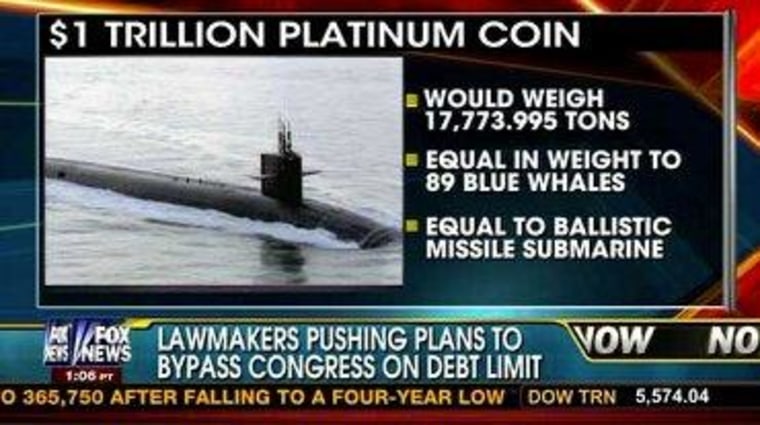I had a little fun at the National Republican Campaign Committee's expense the other day, when the NRCC mistakenly argued that a $1 trillion platinum coin would necessarily need $1 trillion worth of platinum. That didn't make any sense; the NRCC became the butt of jokes for a few hours; and the political world got a nice little lesson on how money works.
Everyone, that is, except the folks at Fox News, who yesterday made the exact same mistake.
Jed Lewison flagged this Fox report, which effectively took the Republican error from Wednesday and turned it into a broadcast error on Thursday. As the network sees it, a $1 trillion platinum coin would weigh nearly 18,000 tons, you know, because of all that platinum.
In a way, this offers another helpful example of epistemic closure on the right -- the NRCC's error generated widespread mockery, but primarily among those who understand the basics of the debt-ceiling fight. In other words, those who pointed to the Republicans' error are the kind of folks Fox News routinely ignores, so the network had no idea that the NRCC stunt was a fiasco.
Which is exactly why Fox had no qualms about running with it on the air, just as the Republican campaign committee probably intended. The network didn't realize it was wrong, and doesn't listen to those who would have explained it to them.
That said, for the record, the argument Fox News pushed yesterday only makes sense among those who don't understand how money works.
Matt Yglesias had a good overview of Currency 101.
In my wallet right now I have a bunch of $20 bills, a few $1 bills, and a $5 bill. These bills are worth different amounts of money due to the fact that they have different numerals written on them. In terms of their actual contents, there's very little difference but a $20 bill is much more valuable than a $1 bill just because. By the same token, if you write a check for $20,000 it doesn't need to be physically different from a $200 check except for having different numerals written on it.Coins are the same. Dimes are more valuable than nickels even though they're smaller. It is true that several hundred years ago the value of a coin was driven by its metallic content, but this hasn't been the case for a long time.... If you think about it for a second you'll see that it basically has to be this way. Quarters and pennies and dimes and nickels all have different metallic content. Since the relative prices of different commodities fluctuates on a daily basis, if the value of coins were based on the value of the metal they contain then the relative value of different coins would be constantly shifting. You'd have to fire up your Bloomberg machine every morning to see how much money the coins in your pocket are worth. That'd be nuts, which is why they write numbers on the coins.
The fact that Republicans and their media allies fail to understand this is, to put it mildly, discouraging.
How do we know a $10 bill is worth $10 or a quarter is worth 25 cents? It's not because there's $10 worth of paper in the former or 25 cents worth of metal in the latter. It's because the government of the United States created the currency, assigned it a value, and everyone, around the globe, accepts the value as legitimate.
If the United States government chose to create a $1 trillion platinum coin, the same would be true.
